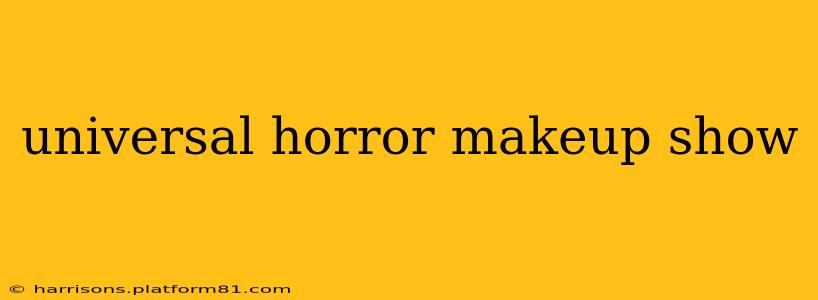The Universal Horror films of the 1930s and 40s remain iconic, not just for their groundbreaking storytelling but also for their groundbreaking makeup effects. These weren't your typical stage makeup jobs; they were transformative creations, bringing to life some of cinema's most memorable monsters and villains. A "Universal Horror Makeup Show," if it existed, would be a fascinating glimpse into the artistry and dedication behind these chilling masterpieces. Let's delve into what such a show might entail.
What Makeup Techniques Were Used in Universal Horror Films?
The makeup artists at Universal Studios were true pioneers, working with limited technology to achieve astonishing results. Their techniques, while seemingly primitive by today's standards, were incredibly effective and continue to inspire makeup artists even now. They primarily relied on:
- Sculpting with wax: This was a cornerstone of their process. Wax appliances were meticulously sculpted and applied to the actor's face and body to create monstrous features like fangs, scars, and grotesque deformities.
- Application of paints and pigments: A range of colors and techniques were used to achieve the desired texture and tone. This involved careful blending and layering to create depth and realism.
- Hairwork: Wigs and hairpieces were crucial in transforming actors. Adding extra hair, changing hair color, or even creating unusual hair textures contributed significantly to the characters' overall appearance.
- Prosthetic pieces: Though less common than sculpting, prosthetic pieces played a role in certain transformations. These added elements could include broken noses, extra limbs, or other dramatic features.
How Did Universal's Makeup Differ From Today's Special Effects?
The biggest difference between Universal's makeup and modern special effects lies in the technology. They lacked the sophisticated digital techniques we have today. Their artistry was entirely practical, relying on skill, patience, and a deep understanding of human anatomy. The results, while sometimes less seamless, possess a tangible, almost visceral quality that many find more captivating than the polished perfection of CGI. The imperfections actually add to the unsettling realism of these classic monsters.
What Were Some of the Most Famous Universal Horror Makeup Creations?
A Universal Horror Makeup Show would undoubtedly showcase the most iconic creations:
- Frankenstein's monster (Boris Karloff): Jack P. Pierce's groundbreaking makeup for Frankenstein's monster is arguably the most famous in horror history. The flat head, visible neck bolts, and scarred features created a truly unforgettable image.
- Dracula (Bela Lugosi): Lugosi's sharp features and pale skin were enhanced with subtle makeup, highlighting his aristocratic yet sinister presence. The focus was less on grotesque effects and more on creating an unsettlingly handsome villain.
- The Wolf Man (Lon Chaney Jr.): The werewolf transformation was a marvel of makeup artistry, using hair and prosthetics to create a truly terrifying creature.
- The Mummy (Boris Karloff): The Mummy's makeup involved extensive use of bandages and makeup to create a decaying, ancient creature.
Who Were the Key Makeup Artists at Universal?
Jack P. Pierce stands out as the most celebrated makeup artist of the Universal Horror era. His innovative techniques and artistic vision shaped the look of these iconic films and left an indelible mark on the genre. A "Universal Horror Makeup Show" should certainly highlight his contributions and the evolution of his style throughout his career.
Could a Universal Horror Makeup Show Still Be Done Today?
Absolutely! A modern Universal Horror Makeup Show could be a highly successful event, combining demonstrations of classic techniques with a showcase of modern makeup artistry inspired by those early masterpieces. It could explore the evolution of horror makeup, featuring artists replicating classic looks alongside artists showcasing contemporary interpretations. Such a show would appeal to both horror fans and makeup enthusiasts, offering a unique blend of history, artistry, and entertainment.
What Other Universal Monsters Would Be Featured?
Beyond the most famous, a comprehensive show would also include explorations of the makeup of creatures like the Creature from the Black Lagoon, the Invisible Man (considering the makeup required to suggest invisibility), and the many other memorable monsters and villains from Universal's extensive horror catalog. Each character offers a unique challenge and opportunity for showcasing different makeup techniques and artistic approaches.
